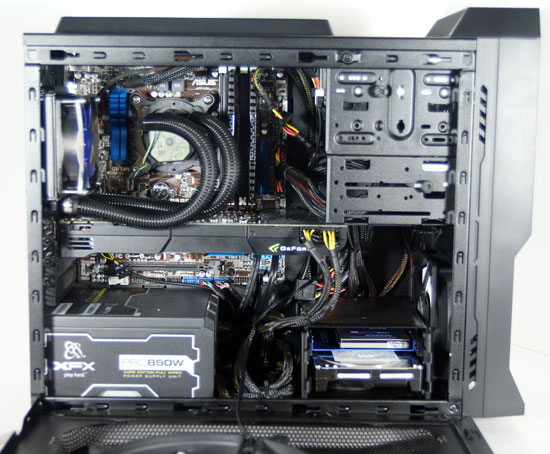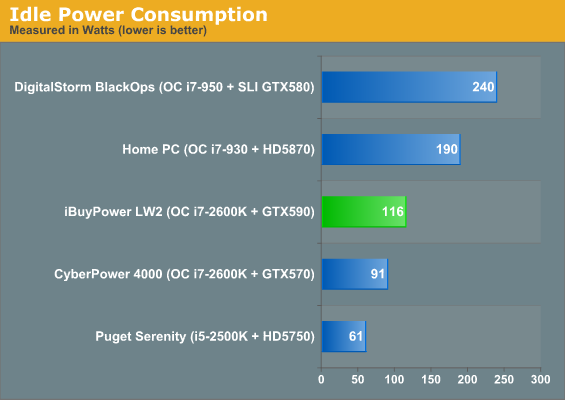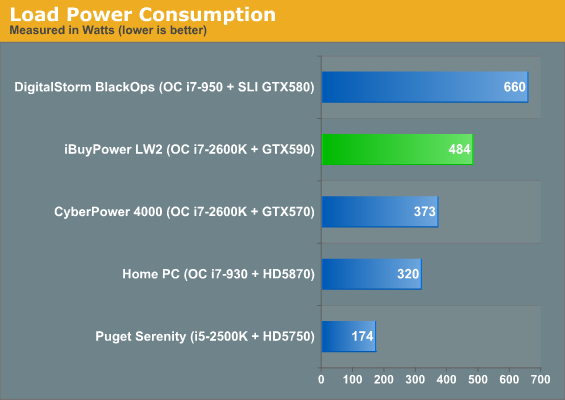iBUYPOWER LAN Warrior II: NVIDIA's GeForce GTX 590 in a Small Shell
by Dustin Sklavos on March 29, 2011 3:00 PM ESTBuild, Noise, Heat, and Power Consumption
As far as build quality goes, the iBUYPOWER LAN Warrior II's claim to fame is being a "portable" gaming machine. The MicroATX case actually comes with a handle (not included in our review unit), and iBUYPOWER's engineers have gone to great lengths to keeping this machine cool by custom sourcing a 92mm water-cooling kit for the processor. While the LAN Warrior II is certainly the lightest desktop I've tested short of AVADirect's diminutive Nano Gaming Cube, it's still heavy enough to be a pain to move. This isn't iBUYPOWER's fault so much as it's the nature of the beast: desktop PCs are heavy, period, and this much high-end hardware merely exacerbates the problem.
With that said, the assembly is excellent (especially given how fast the unit was sent to us), but I can't help but split hairs with the NZXT Vulcan case. At $69 retail it's not the cheapest case in the world but it's not exactly what you expect to find on a two-thousand dollar desktop machine either--this is a cut corner I've harped on CyberPowerPC for, too. It's not that the Vulcan is a bad case--cooling is actually very efficient and effective (as we'll see in a bit), the 200mm side intake fan does wonders for keeping the GTX 590 cool, and the integrated fan controls are much appreciated. At the same time, there are swankier cases being used by other manufacturers that could do the job and do it better; in house I have a machine built in an Antec Mini P180 that's been modified to include an intake fan in the side panel, and that system produces comparable performance with much lower noise. It also didn't require me to bring to bear the full strength of my robust 5'8", 130-pound frame to remove one of the side panels.

The LAN Warrior II's big victories do stem from the excellent thermal and acoustic qualities of the NZXT Vulcan, though. While it's not the quietest case in the world, turning the fans all the way down produces reasonably low noise levels while still keeping the internal components nice and frosty. That's good, because the rushed overclock shows with the telltale gripe I've had with most of these boutique systems: lack of fine tuning. The BCLK was raised to 105, and the voltages were all left at auto. At least the motherboard is defaulting to using an offset instead of just running at a constant high voltage the way the DigitalStorm BlackOps did, but a more efficient overclock can do away with even needing a water-cooling loop in the first place. And what about those temperatures, anyhow?

They're pretty good, actually. Of particular note is the GTX 590 that's cruising along at under 80C under load, which is downright impressive. Meanwhile the i7-2600K never breaks 60C under load, a testament to both the water-cooling loop and the fact that a loaded Sandy Bridge processor warms up a room about as much as a hot fart.
Acoustically the system does run quietly given what's inside, but the GTX 590 will not be beaten. While running the STALKER benchmark, I could actually sit on the other side of the room, watch "Video Dead," and know the benchmark was finished running by the sudden silence in the room. This still isn't comparable to the whine of a screaming Radeon HD 6990, but it does speak to both the noise required to cool 375 watts worth of GPU power alongside the relative lack of attention paid to the acoustics of the case.


Idle power is pretty reasonable considering the high performance on tap, and naturally the GTX 590 isn't going to do you many favors under load. Overall, the power draw is about what you'd expect for the components, so other than noting that you'll use substantially more power for the GTX 590 than you would for GTX 570, there's not much to say.
















26 Comments
View All Comments
darckhart - Tuesday, March 29, 2011 - link
everything seems pretty good here. of course, it's up to the buyer to determine value, but surely your gripe with the case is far overblown. it got the job done well. it's cheap (comparatively). i think they've done a decent job.one other thing your review concerned me with was the video part. surely you should have stepped up the res to 25x16 and started cranking AA before mentioning surround.
Dustin Sklavos - Tuesday, March 29, 2011 - link
You'll note when I listed my monitors, I don't have a 30"er capable of 2560x1600.leexgx - Tuesday, March 29, 2011 - link
the issue with getting the monitors to work happens on my system as well and I only have 1 GTX480takes about 4-5 reboots before i can get both monitors to work and show an picture (some times it switch's between the screens on reboots when the cables are messed with unplug replug), not sure why but i know it only does it when i remove the video card and reinstall it (Dust bunny clean out)
Paedric - Tuesday, March 29, 2011 - link
I'm not really into overclocking and all, but there was something I was wondering after seeing several articles mentioning the subject.Can't you change the factory overclock?
I mean, I know manufacturers should do better overclocks, since this is one of the reasons people are buying those kinds of machines, but if the one they do is rather poor, isn't it possible to improve it?
In a past review, I believe the voltage was constant, leading to a high idle draw, is it lock in the hardware, and plain impossible to change; more difficult than on custom-built rigs, or the same?
krumme - Tuesday, March 29, 2011 - link
I agree.Dustin - overclock the 590! - What driver are you using.
Btw: please make a movie of it - we like action :)
ggathagan - Tuesday, March 29, 2011 - link
I disagree.When reviewing a system component, like a CPU or motherboard, it makes sense to for the reviewer to spend some time trying to get the best overclock possible within the time they have.
When reviewing a system, however, the dynamic changes; especially when dealing with a boutique system from a company that markets itself in the fashion that iBuyPower does.
In that scenario, it's the *company's* job to get the most out of the system they sell you.
That is a good part of what you are paying for.
I can't speak for AT, but I certainly would have preferred that iBuyPower hold off on sending a review unit for a few days or a week and spend some time optimizing the system.
If the extra time wouldn't alter their approach to tweaking the system, that says something as well.
strikeback03 - Thursday, March 31, 2011 - link
Also, they have had a couple months of experience with SNB, why the lazy overclock there? If the reason for the rushed nature of the assembly was a late delivery of the video cards then I could see not tweaking the video card, but why was the processor not overclocked in a better fashion, given that turning the multiplier up should be easy?Jarp Habib - Tuesday, March 29, 2011 - link
I'm not seeing any power consumption figures (idle, load) in the Build, Noise, Heat and Power Consumption page. I'd rather see those (even though these are desktop systems!) than wildly variable PCMark scores.sulu1977 - Tuesday, March 29, 2011 - link
How reliable is this water cooling?How often do you need to replace the water?
Does it ever leak?
Does it ever cause rust?
Does it slowly evaporate and disappear?
Does the water pump ever need replacing or oiling?
B3an - Tuesday, March 29, 2011 - link
How can you ask this common knowledge?How can you act as if water cooling is anything new?
How can you not use Google?
But seriously... in order to your questions:
Very, depending on the kit.
Once a year if that.
Not if done properly.
No.
Very slowly, once a year water top ups.
I've had mine for 5 years and it's fine.